Explain what the user is reading
Write a sentence explaining what the flowchart text alternative is about and include a link to the visual flowchart. For example:
This text alternative provides an accessible summary of the Career Break Policy visual flowchart [PDF].
Start with a flowchart overview
Begin with a brief overview of the chart structure to give the user a high-level understanding of the basic flow. Do not go into detail here. For example:
Chart begins with an employee and their manager having an initial early conversation about a career break. Then the employee submits their career break application form and meets with their manager to discuss the request.
If the career break request is agreed upon, the employee and their manager complete an agreement.
The employee and their manager discuss return to work arrangements.
If the employee is returning to work on the agreed date and their career break is less than 12 months, they will return to work. If the career break is longer than 12 months, they will return to their substantive post, if available, otherwise, they will be added to the redeployment register. They will then follow their Board’s local redeployment process and the process ends.
If the employee is not returning to work on the agreed date, then they inform their manager of a request to amend the date. If the request is accepted, then the manager confirms the outcome in writing. The employee can appeal the outcome if the request is not accepted.
If the employee is not returning to NHS employment, they must provide written notice in line with contract terms and conditions.
This is an overview of the NHS Scotland Career Break Policy [PDF].
Describe the flowchart in detail
After providing a high level overview of the flowchart you would then describe each step in the flow.
Start the description with ‘Chart begins with’ and then the text from the first step. For example:
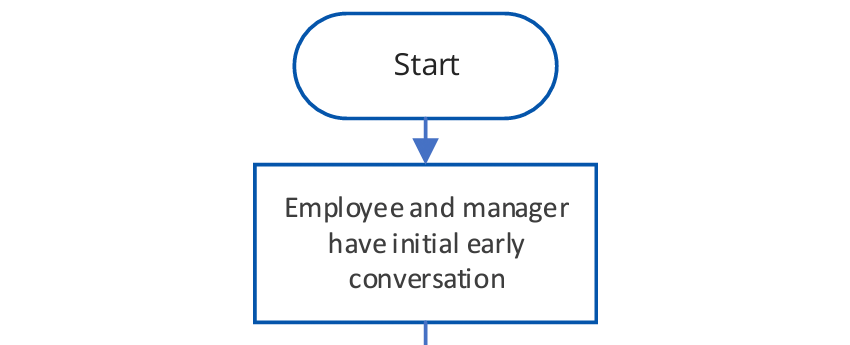
The flow above would read:
Chart begins with the employee and the manager having an initial early conversation.
While it's crucial to stick to the text on the flowcharts, our research suggests that the flow becomes much more understandable when the text reads like a regular sentence. If a sentence feels overly awkward with the exact wording, you can use minimal conjunctions (such as or, and, but, because, for, if, and when) or additions to make it flow more naturally.
Questions or decisions
Questions should be preceded by the phrase ‘then the question is asked,’. For example:

The flow above would read:
Then the question is asked, career break request agreed?
The first time a question is asked, include the question mark at the end of the sentence.
Answering questions
When describing the yes and no flows from a question, repeat the question in the sentence without the question mark. For example:
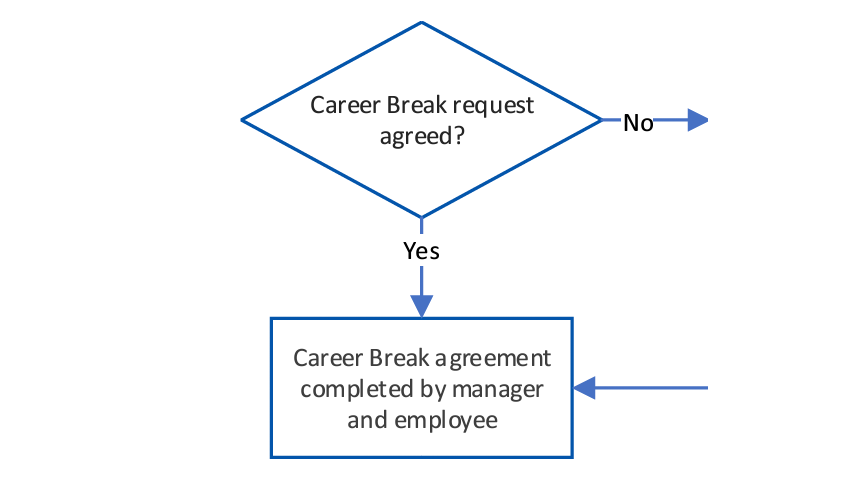
The flow above would read:
If the answer is yes to the question, career break request agreed, then the flow connects to the step, career break agreement completed by manager and employee.
This may seem repetitive, however this has been done because there can be several steps between the yes and the no flows. This can make it difficult for users to keep track of which question the 'yes' and 'no' is referring to.
If an answer leads to the end of a flow, then this flow should be described within the same paragraph and before the alternative flow which will be in a new paragraph. For example:
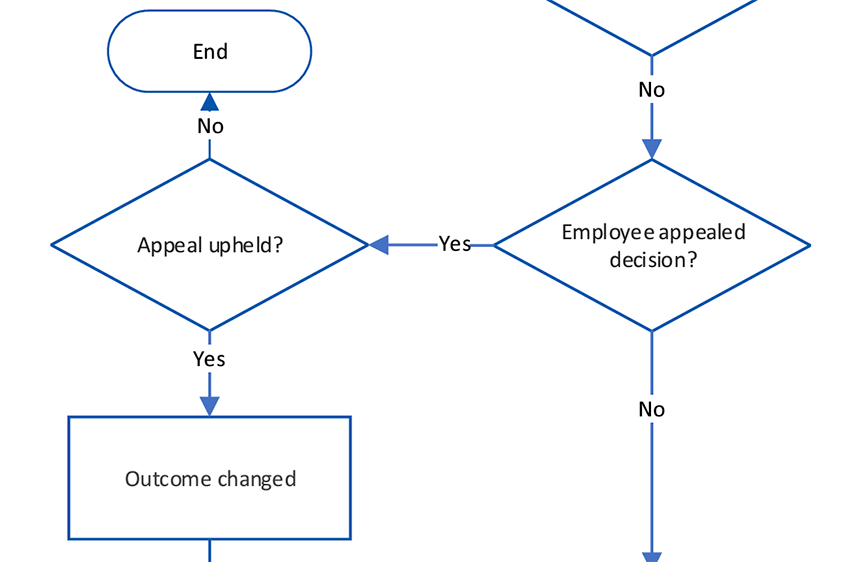
The above flow would read:
If the answer is yes to the question, employee appealed decision, then the question is asked, appeal upheld?
If the answer is no to the question, appeal upheld, then the process ends.
If the answer is yes to the question, appeal upheld, then the outcome is changed.
Steps
Unless it is the first step in the flow, start the step description with the word ‘then’ for example:
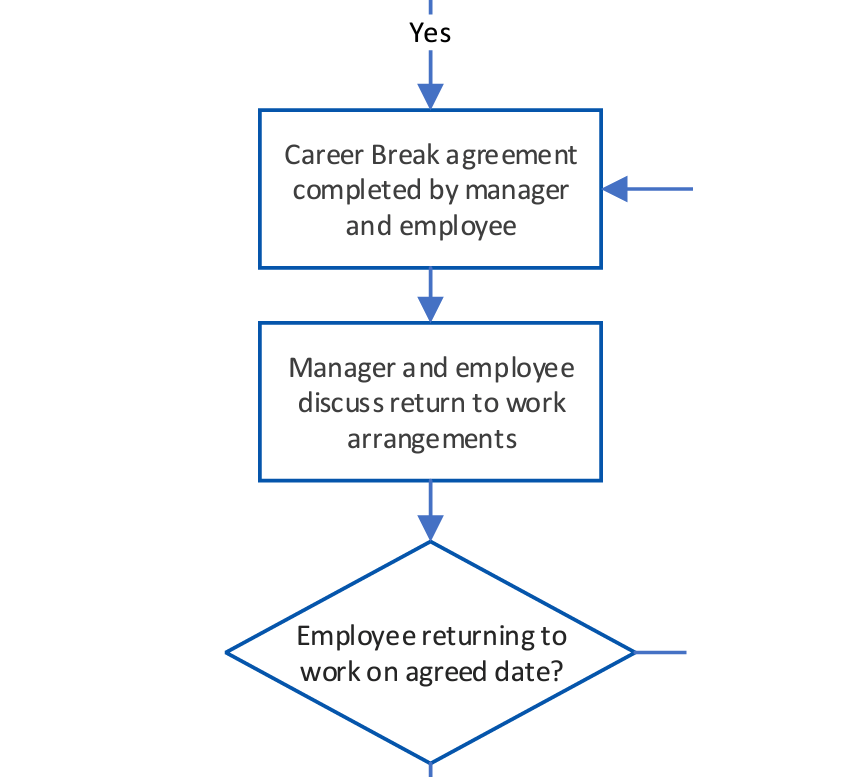
The above flow would read:
Then the career break agreement is completed by manager and employee.
Then the manager and employee discuss return to work arrangements, then the question is asked, employee returning to work on agreed date?
Flow goes back to previous steps
If the flow returns to a step in the flow already described, use the phrase, 'then the flow returns to the step,'. Use an anchored link to allow the user to go directly to this step. Explain that they can follow or skip the link. For example:
To return to this step, follow the next link, otherwise skip the next link. Jump to the step, Stage 3 hearing.
Flow continues to step further along the chart
If the flow connects with steps further along the flow, use the phrase:
'then the flow connects to the step,'. Use an anchored link to allow the user to go directly to this step. Explain that they can follow or skip the link. For example:
To go to this step, follow the next link otherwise skip the next link. Jump to the step, refer to the Workforce Policies Investigation Process.
Multiple options
When there are multiple options these can be labelled as:
- Steps
- Outcomes
- Options
- Actions
- Questions
Use an ordered list to list the options.
Here are some examples of how these should be formatted.
Multiple options example 1:
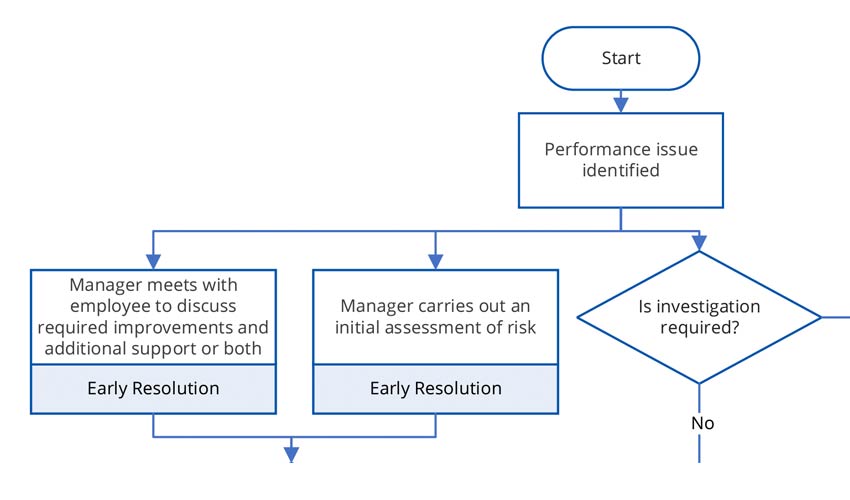
The flow above would read:
Chart begins with a performance issue being identified. Then there are three steps:
-
- Manager meets with employee to discuss required improvements and additional support or both
- Manager carries out an initial assessment of risk
- The question is asked, is investigation required?
Multiple options example 2:
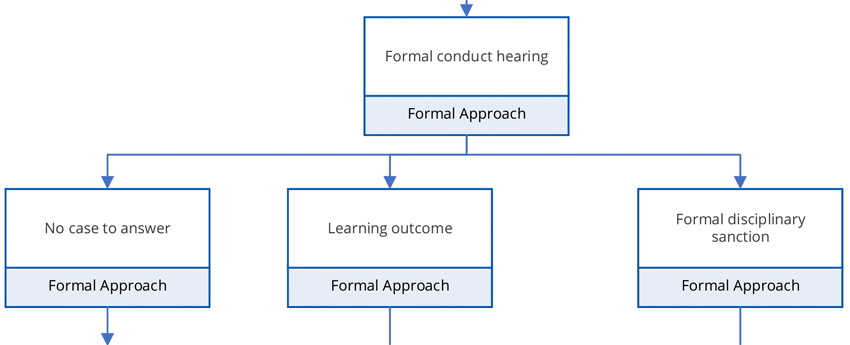
The flow above would read:
Then formal conduct hearing, then there are three possible outcomes:
-
- No case to answer
- Learning outcome
- Formal disciplinary sanction
General guidance
If there are clear stages in the flow use headings to structure the content under the headings. The NHS Scotland Capability Policy flowchart text alternative is an example of a flow with distinct stages.
When the flowchart uses a format like ‘meeting(s)’ with the ‘s’ in brackets to indicate it can be one or many meetings write this as ‘meeting or meetings’. This format will be more meaningful when read out by the screen reader.
Example flowcharts
You can see varied examples of flowchart text alternatives on each of the policies on the NHS Scotland Workforce Policies website. To access them, visit the policy page and scroll down to the flowchart section. The link to the text alternative is positioned ahead of the PDF link for the flowchart. This arrangement ensures that screen reader users are aware of the alternative option and do not unintentionally navigate to the PDF without knowing there's an accessible alternative available for them. You can also find them by filtering for flowcharts on the supporting documents page.